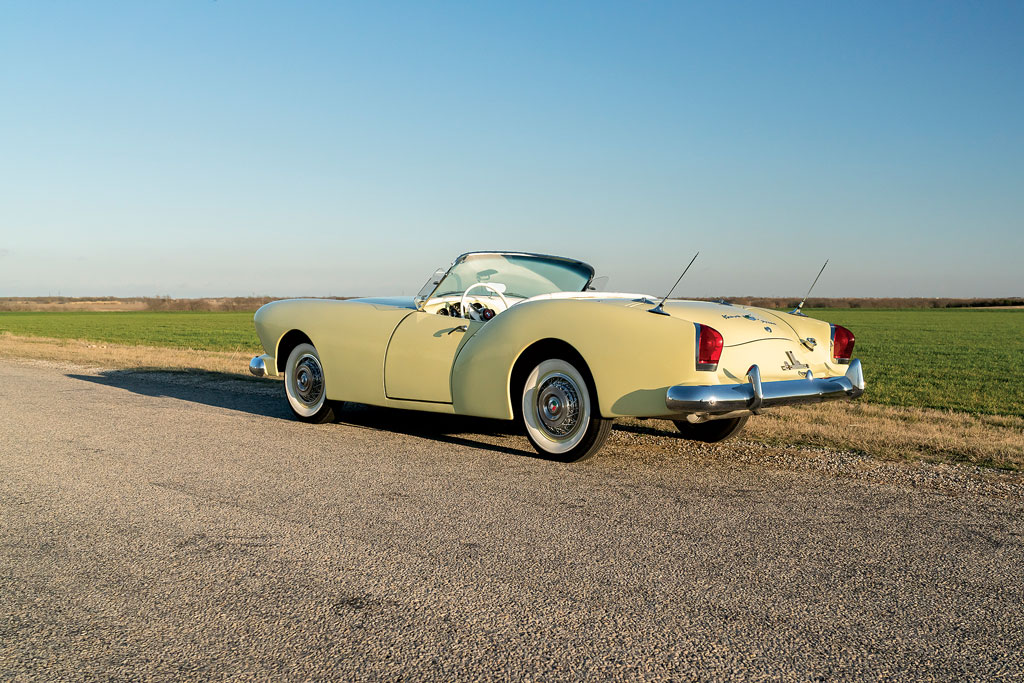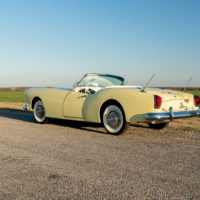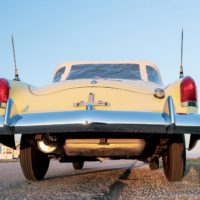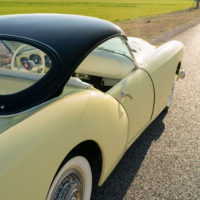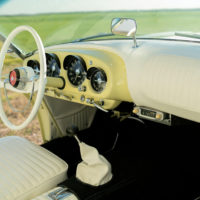SCM Analysis
Detailing
| Vehicle: | 1954 Kaiser-Darrin |
| Years Produced: | 1954 |
| Number Produced: | 435 |
| Original List Price: | $3,668 |
| SCM Valuation: | $93,000 |
| Chassis Number Location: | Left front door post |
| Engine Number Location: | Right front corner of engine block |
| Club Info: | Kaiser Frazer Owners Club |
| Website: | http://kfoci.wildapricot.org |
| Alternatives: | 1953–55 Chevrolet Corvette, 1954–59 Arnolt-Bristol, 1955–57 Ford Thunderbird |
| Investment Grade: | B |
 This car, Lot 259, sold for $137,500, including buyer’s premium, at RM Sotheby’s Online Only: Open Roads sale, on February 28, 2021.
This car, Lot 259, sold for $137,500, including buyer’s premium, at RM Sotheby’s Online Only: Open Roads sale, on February 28, 2021.
Howard “Dutch” Darrin was an American flier during World War I, dogfighting over the French countryside. He returned to Paris after the war and, along with Thomas Hibbard, became an agent for the Belgium-built luxury automobile Minerva. When the automaker was forced to reorganize, Hibbard and Darrin evolved into a full-service design and custom shop in Paris. They built several concept cars for General Motors, which led to Hibbard leaving to be in Harley Earl’s employ.
Darrin then became involved with wealthy French banker J. Fernandez and formed Carrosserie Fernandez et Darrin, designing and building sensational cars for the likes of Greta Garbo, Prince Azur and an endless string of millionaires. An Argentinean playboy popularly known as “Macoco” was their best client, acquiring 26 Fernandez and Darrin-designed automobiles. Sales, however, declined and they closed their doors in 1937.
Back in the U.S.A.
Returning to the United States, Darrin settled in Hollywood, where he established Darrin of Paris on Sunset Avenue and created exciting automotive designs for screen stars and other notables. His Packard designs were a sensation, and with movie stars such as Dick Powell and Clark Gable as clients, he prospered.
After the war, however, the market for custom coachwork had all but vanished. The carmakers were selling everything they could produce to a product-starved country. Darrin entered into a rather tumultuous relationship with Kaiser-Frazer as a freelance consultant. He quickly left when his design for the 1946 sedan was altered. He returned to design the 1947 Kaiser and the Frazer, under a deal in which he received 75 cents for each one sold. He also designed the forgettable 1951 Kaiser Manhattan. His design for the 1951 Henry J was rejected and he again resigned, claiming that this time it was final.
Darrin would not let his design for the Henry J go. With assistance from Bill Tritt, who founded Glasspar in 1949, he built a clay mockup for a stylish sports car on the Henry J chassis. He did this on his own without approval or knowledge of Kaiser management, financing it out of his own pocket. Glasspar built the fiberglass body and Henry Kaiser was invited to view the design. He was not impressed, but his new wife was — and she carried the day. Thus, on a woman’s intuition, the Kaiser-Darrin was born.
Beating the Corvette
The fiberglass body was novel and was indeed announced several months before the Corvette. (However, it was the Glasspar-built G2 that was actually the first fiberglass car, contrary to what was stated in the catalog description.) But production of the Kaiser-Darrin was delayed as negotiations regarding sourcing an engine from General Motors faltered. A Willys “Hurricane” 6 was used instead.
Like the Corvette, the Kaiser-Darrin stretched the definition of a sports car. The car’s unique design featured a “rosebud” grille which many thought resembled a guppy feeding. The most remarkable feature of the car was its pocket doors, which slid — often awkwardly — into the front fenders.
Priced at $3,668, it was more expensive than the Cadillac Series 62. As a result, only 435 were produced. When it all came to an end, the final 50 were ordered destroyed. Darrin was able to acquire them and continued to offer the cars for sale as late as 1957. He dropped Cadillac V8s into the final six, and at least one of the final 50 was fitted with a supercharger, as had been used on the 1954 Manhattan.
Final 50
Our subject car was one of the last batch, which doesn’t affect value so much as it gives the owner a story to tell. A Paxton-McCulloch supercharger had been added, with the necessary mounting brackets for it said to have been cast from parts from an original car. Perhaps more interesting is that an optional removable hard top was included, one made from the original molds. This was an accessory that had been offered by the factory, and although somewhat functional, it did not add much to the aesthetics of the design.
The values for Kaiser-Darrins have been depressed of late — along with most all ’50s cars — but several recent sales noted in the SCM Platinum Auction Database have been in the range of what we see here. The quality of our subject car’s recent restoration was exceptional, and based on comparable sales, we have to conclude that this car sold for a market-correct amount. ♦
(Introductory description courtesy of RM Sotheby’s.)
